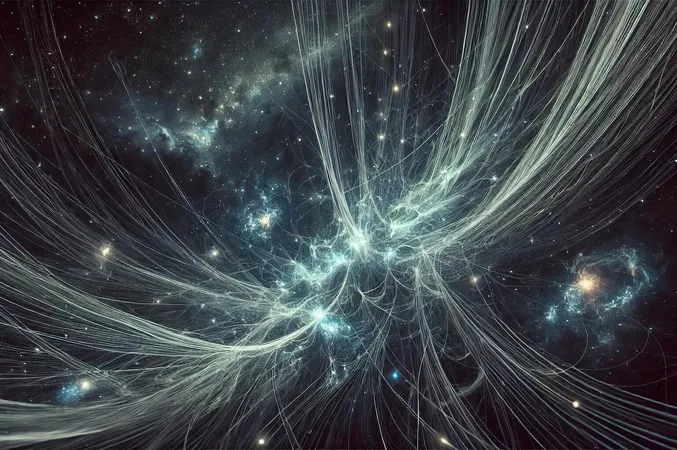
Astrophysicists Make Groundbreaking Discovery: First Likely Detection of Cosmic Strings!
2025-01-01
Author: Jessica Wong
Introduction
In a remarkable intersection of ancient cosmology and cutting-edge astrophysics, researchers at the Indian Institute of Astrophysics have reportedly identified potential candidates for cosmic strings—the elusive remnants from the universe's earliest moments. This finding has ignited excitement within the scientific community, as it could revolutionize our understanding of the cosmos.
The Big Bang and Cosmic Strings
The origins of the universe were characterized by an unimaginable explosion known as the Big Bang, which not only generated matter and energy but also set the stage for various phenomena, including a significant event less than a millionth of a second after the explosion: a phase transition in the quantum field. During this brief moment, our universe cooled, leading to a controversial theoretical concept: cosmic strings. These one-dimensional structures, theorized to emerge from defects in spacetime, have puzzled scientists since the 1970s when they were first proposed by physicist Tom W. B. Kibble.
Historical Context
Kibble's ideas sparked intriguing discussions in the astrophysics community, culminating in the 1980s when physicists like Alexander Vilenkin suggested cosmic strings could play essential roles in galaxy formation. The implications of these strings further intertwined with String Theory, creating a compelling narrative that scientists are still exploring today, especially with advanced gravitational wave observatories like LIGO and Virgo on the hunt for evidence.
Recent Discoveries
The latest revelations focus on a specific region of space, dubbed CSc-1, where researchers identified a pair of galaxies cataloged as SDSSJ110429.61+233150.3. Upon closer examination, these celestial bodies may not be separate entities; rather, they could be the same galaxy observed through the warped perception of gravitational lensing, potentially caused by a cosmic string.
Gravitational Lensing and Cosmic Strings
The researchers state, 'The significant correlation between the spectra of the two components indicates the possible gravitational lensing nature of the pair.' Their simulations suggest that the peculiar alignment and characteristics of this duo could indeed link back to a cosmic string's gravitational influence—an astonishing proposal but not without reservations.
Calls for Caution
As scientists delve deeper into the implications of their findings, the absence of detectable mass between the 'twinned' galaxies poses questions. Could they be two distinct galaxies rather than a single object split into two? Recognizing the complexity of their research, experts urge caution, emphasizing the need for further investigation to corroborate their findings.
Future Research Directions
The team calls for an intensive study of the CSc-1 field with advanced telescopes, like the Devasthal Optical Telescope in Nainital, which boasts the capabilities necessary for a deeper search into these cosmic mysteries.
Conclusion and Implications
This groundbreaking research, while still in its early stages and awaiting peer review, could represent a pivotal moment in our quest to understand cosmic strings and the remnants of the universe's infancy. The expert community remains hopeful that this could precipitate a renewed era of discovery in astrophysics, bridging the gap between observation and theory.
While final conclusions have yet to be drawn, the implications of such findings are profound. They not only open up new lines of inquiry into the nature of the universe but also fuel the age-old human curiosity about our cosmic beginnings. Will these potential candidates finally unlock the mysteries behind cosmic strings? Only time and further investigation will tell, but the journey for answers is already excitingly underway!

 Brasil (PT)
Brasil (PT)
 Canada (EN)
Canada (EN)
 Chile (ES)
Chile (ES)
 Česko (CS)
Česko (CS)
 대한민국 (KO)
대한민국 (KO)
 España (ES)
España (ES)
 France (FR)
France (FR)
 Hong Kong (EN)
Hong Kong (EN)
 Italia (IT)
Italia (IT)
 日本 (JA)
日本 (JA)
 Magyarország (HU)
Magyarország (HU)
 Norge (NO)
Norge (NO)
 Polska (PL)
Polska (PL)
 Schweiz (DE)
Schweiz (DE)
 Singapore (EN)
Singapore (EN)
 Sverige (SV)
Sverige (SV)
 Suomi (FI)
Suomi (FI)
 Türkiye (TR)
Türkiye (TR)
 الإمارات العربية المتحدة (AR)
الإمارات العربية المتحدة (AR)